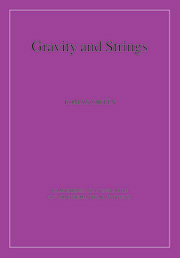Book contents
- Frontmatter
- Contents
- Preface
- Part I Introduction to gravity and supergravity
- Part II Gravitating point-particles
- Part III Gravitating extended objects of string theory
- 14 String theory
- 15 The string effective action and T duality
- 16 From eleven to four dimensions
- 17 The type-IIB superstring and type-II T duality
- 18 Extended objects
- 19 The extended objects of string theory
- 20 String black holes in four and five dimensions
- Appendix A Lie groups, symmetric spaces, and Yang–Mills fields
- Appendix B Gamma matrices and spinors
- Appendix C n-Spheres
- Appendix D Palatini's identity
- Appendix E Conformal rescalings
- Appendix F Connections and curvature components
- Appendix G The harmonic operator on ℝ3 × S1
- References
- Index
14 - String theory
Published online by Cambridge University Press: 20 February 2010
- Frontmatter
- Contents
- Preface
- Part I Introduction to gravity and supergravity
- Part II Gravitating point-particles
- Part III Gravitating extended objects of string theory
- 14 String theory
- 15 The string effective action and T duality
- 16 From eleven to four dimensions
- 17 The type-IIB superstring and type-II T duality
- 18 Extended objects
- 19 The extended objects of string theory
- 20 String black holes in four and five dimensions
- Appendix A Lie groups, symmetric spaces, and Yang–Mills fields
- Appendix B Gamma matrices and spinors
- Appendix C n-Spheres
- Appendix D Palatini's identity
- Appendix E Conformal rescalings
- Appendix F Connections and curvature components
- Appendix G The harmonic operator on ℝ3 × S1
- References
- Index
Summary
In this chapter we start the study of the extended objects that appear in the non-perturbative spectrum of string theory, the subject of the third part of this book. In this part we will make use of all the techniques we have developed in the first and second parts, whose main goal was to serve as a preparation for the third.
In a certain sense, this third part also presents the synthesis and (it is hoped) culmination of the ideas presented in the previous two in the framework of string theory: on the one hand, string theory includes a presumably consistent theory of quantum gravity that contains the gravitons described at lowest order by the Fierz–Pauli theory we studied in Chapter 3 [833, 834]. There are two main differences from the non-renormalizable theory of GR: the presence of a dimensionless coupling constant different from the Planck length and the presence of terms of higher order in derivatives. Furthermore, consistent string theories have spacetime supersymmetry and, therefore, supergravity, which we studied in Chapters 5 and 13. On the other hand, string theory incorporates naturally extra dimensions that have to be compactified. Thus, the ideas of Kaluza and Klein studied in Chapter 11 are also integrated into the picture.
Finally, the Schwarzschild, Reissner–Nordström, pp-wave, etc. solutions studied in other chapters are also solutions of string theory and it is natural to try to use them to solve the puzzles that arise when one tries to do quantum mechanics in those backgrounds: the information and entropy problems.
- Type
- Chapter
- Information
- Gravity and Strings , pp. 405 - 429Publisher: Cambridge University PressPrint publication year: 2004
- 1
- Cited by

